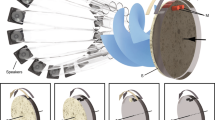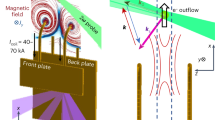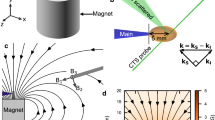Abstract
BY now it is well known1–3 that charged particles moving in harmonically oscillating vacuum electromagnetic fields can be subject to time-average forces which establish a virtual potential minimum for them. The matter takes on a different aspect when the number of particles is so large as to form a highly conducting plasma, as in Kapitza's theory of ball lightning4. Then, quite aside from the details of the particle motions, we know that the radiation pressure of the inflowing electromagnetic radiation is exerted on the energy-dissipating plasma. Thus, if the maintenance of a local ball of fire requires about 20 kW. (2 × 1011 dyne cm. sec.−1), the total force, irrespective of direction, associated with this energy conversion will be 6.7 dynes. To the extent that, besides the 20 kW. absorbed, there may be energy reflected, this number will be greater. A reflected 20 kW. will contribute 13.3 dynes. This is far too little to hold a fire-ball at several thousands of degrees temperature and, say, 10 cm. in diameter from rising under the unidirectional buoyant force of about 600 dynes.
This is a preview of subscription content, access via your institution
Access options
Subscribe to this journal
Receive 51 print issues and online access
$199.00 per year
only $3.90 per issue
Buy this article
- Purchase on Springer Link
- Instant access to full article PDF
Prices may be subject to local taxes which are calculated during checkout
Similar content being viewed by others
References
Wuerker, R. F., Shelton, H., and Langmuir, R. V., J. App. Phys., 30, 3, 342 (1959). Wuerker, R. F., Goldenberg, H. M., and Langmuir, R. V., ibid., 30, 3, 441 (1959).
Watson, W. K. R., Nature, 185, 449 (1960).
Fischer, E., Z. Physik, 156, 1 (1959).
Kapitza, P. L., Doklady, U.S.S.R., 101, 245 (1955).
Cobine, J. D., “Gaseous Conductors” (McGraw-Hill Book Co., 1941).
Schonland, B. F. J., “Lightning”, “Handbuch der Physik”, 22, first ed. (J. Springer Pub. Co., New York, 1959).
Author information
Authors and Affiliations
Rights and permissions
About this article
Cite this article
TONKS, L. Electromagnetic Standing Waves and Ball Lightning. Nature 187, 1013–1014 (1960). https://doi.org/10.1038/1871013a0
Issue Date:
DOI: https://doi.org/10.1038/1871013a0
This article is cited by
-
Ball lightning in the laboratory
Nature (1982)
-
On the formation of ball lightning
Il Nuovo Cimento C (1981)
-
Ball lightning as a radiation bubble
Pure and Applied Geophysics PAGEOPH (1969)
Comments
By submitting a comment you agree to abide by our Terms and Community Guidelines. If you find something abusive or that does not comply with our terms or guidelines please flag it as inappropriate.



